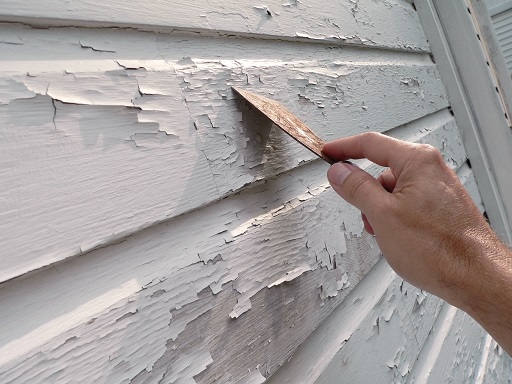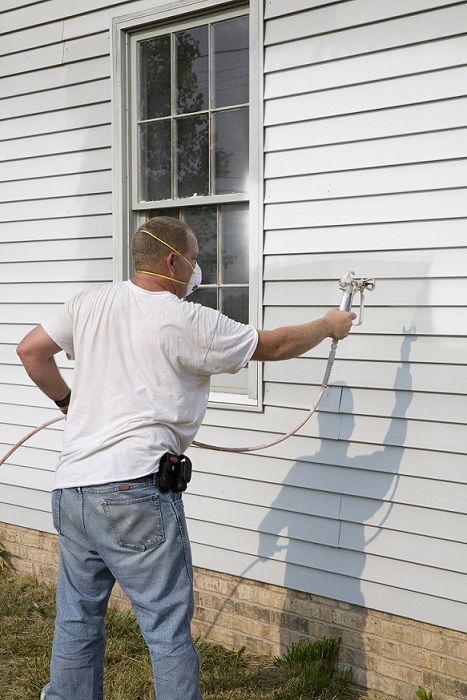Few things can instantly raise your home’s curb appeal and freshen up its appearance like a new coat of paint. Whether you’re just touching up the trim or doing a complete exterior house painting, it’s a cost-effective way to completely transform the look of your home. A fresh coat also protects your residence from the wind, the sun and the rain. Because a quality paint job can last for as much as 15 years, a little extra attention to detail now can keep your home in good condition for years to come. There are a number of important steps, however, you need to be aware of for a paint job that will make your house look as good as new.
Clean Up Your Home’s Exterior
A thorough cleaning of the outer surface is mandatory before any painting can begin. The point is to remove dirt, debris, and any paint residues that could prevent the new coat from adhering. Also, it eliminates the mildew that often grows on paint. Typically, painting contractors use pressure washers to get the job done. If this is a DIY job, you need to be careful because pressure washing can cause damage to the exterior. Hoses, pump sprayers and scrub brushes are also acceptable, if somewhat slower, methods.
Scrape Off Excess or Peeling Paint

The next step is to scrape off any paint that has peeled, bubbled or blistered. If your paint happens to contain lead, you’ll need to take extra steps to protect yourself and your family from toxic dust. Otherwise, you only need a dust mask and tarps to catch debris before you begin. Again, you have a couple of choices here. Using a hand scraper takes time and is more labor intensive. On the other hand, it’s a less damaging way to remove older layers than power sanders and grinders.
Sanding Down for a Smooth Surface
As soon as all the loose paint is removed, it’s time to start sanding down the surface to create a nice smooth finish. Pad sanders will make this job go much faster than sanding by hand. In addition to making a smooth finish, sanding makes the surface more adhesive by creating small ridges to which the paint can more easily stick.
Time to Apply Primer
At this point, it’s time to prime the surface to prepare it for the paint. Primers are designed to penetrate, seal and lay a good foundation for the top coat to adhere. For this reason, they can be applied over spackle, bare wood, and deteriorated paint. If the paint surface is clean, however, it’s okay to skip the primer.
Picking the Right Color
Before you begin applying paint, you need to decide on the right color for your exterior makeover. There are also a number of factors you should take into account before making your decision.
- The surrounding landscape: it helps to consider trees and shrubbery around your home when picking out your color scheme. For example, homes surrounded by many trees will appear darker and have more shadows. In this case, you might want to try using a lighter color.
- Special details: your paint job should emphasize the parts of your exterior that make it special. For this reason, you could choose a color that highlights entryways, windows and shutters.
- Hiding flaws: you can also use a paint color to hide imperfections. For instance, using two shades of one color can make your home appear more proportionately sized. Darker colors can make an area appear smaller if necessary. Or you might use lighter tones, so a home may not seem camouflaged by trees or shadows.
Start Painting

After you’ve picked out the right color for your exterior, it’s time to begin. You still need to decide, however, how you want to apply the paint. Most contractors will use paint sprayers because of their efficiency. Nevertheless, they can result in drips or a mist that lands on other areas besides your house if you don’t have experience with them. For this reason, it’s important to remove or mask off everything in the area that could get stained when using sprayers.
The main thing to know about painting a house is that you start at the top and work your way down. You should also do everything you can to work in the shade. It’s also helpful to pay attention to the weather. Rain can actually wash fresh latex paint right off a surface, and colder temperatures (i.e. below 50 degrees Fahrenheit) can cause problems with paint adhesion.
If you’ve decided to do it yourself rather than hire a contractor, using a brush is probably your best bet. Even if you use mini-rollers, you will need to follow up soon after with a brush. Regardless of you how you apply the paint, two top coats will always result in a better, longer-lasting paint job than one. The second coat tends to even everything out and makes for a better shell around your house.
Apply the Finishing Touches
Your final step is to paint the shutters, doors, molding, and any other decorative parts of the exterior. A good brush should do the trick, but you can use smaller 6-inch rollers here as well. If you follow these steps and do the job right, there’s every reason to believe that you can get anywhere from 10-15 years out of your new paint job.
Home Improvement Market
The Home Remodeling industry, similar to the wider housing sector, has continued to grow over the five years to 2022, as a result of several economic factors that have encouraged consumers to increase spending on home improvements. Operators in the Remodeling industry remodel and renovate the interiors and exteriors of residential buildings, which includes activities such as additions, alterations, reconstruction, maintenance and repair work. A decline in unemployment has led to improvements in consumers’ disposable income levels, causing homeowners to undertake more professional remodeling projects, thereby benefiting industry demand. If you are looking for a local residential remodeler, make sure to find an experienced professional contractor with online reviews and a good track record. Lower bidder is not always a good one, and could cost you more in the long run.
Check our local listing of top home remodeling contractors.

